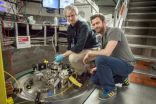(Press-News.org) When two different sized galaxies smash together, the larger galaxy stops the smaller one making new stars, according to a study of more than 20,000 merging galaxies.
The research, published today, also found that when two galaxies of the same size collide, both galaxies produce stars at a much faster rate.
Astrophysicist Luke Davies, from The University of Western Australia node of the International Centre for Radio Astronomy Research (ICRAR), says our nearest major galactic neighbour, Andromeda, is hurtling on a collision course with the Milky Way at about 400,000 kilometres per hour.
"Don't panic yet, the two won't smash into each other for another four billion years or so," he says.
"But investigating such cosmic collisions lets us better understand how galaxies grow and evolve."
Previously, astronomers thought that when two galaxies smash into each other their gas clouds--where stars are born--get churned up and seed the birth of new stars much faster than if they remained separate.
However Dr Davies' research, using the Galaxy and Mass Assembly (GAMA) survey observed using the Anglo-Australian Telescope in regional New South Wales, suggests this idea is too simplistic.
He says whether a galaxy forms stars more rapidly in a collision, or forms any new stars at all, depends on if it is the big guy or the little guy in this galactic car crash.
"When two galaxies of similar mass collide, they both increase their stellar birth rate," Dr Davies says.
"However when one galaxy significantly outweighs the other, we have found that star formation rates are affected for both, just in different ways.
"The more massive galaxy begins rapidly forming new stars, whereas the smaller galaxy suddenly struggles to make any at all.
"This might be because the bigger galaxy strips away its smaller companion's gas, leaving it without star-forming fuel or because it stops the smaller galaxy obtaining the new gas required to form more stars."
The study was released today in the journal Monthly Notices of the Royal Astronomical Society, published by Oxford University Press.
So what will happen in four billion years to the Milky Way and Andromeda?
Dr Davies says the pair are like "cosmic tanks"--both relatively large and with similar mass.
"As they get closer together they will begin to affect each other's star formation, and will continue to do so until they eventually merge to become a new galaxy, which some call 'Milkdromeda'," he says.
INFORMATION:
Further Information:
ICRAR is a joint venture between Curtin University and The University of Western Australia with support and funding from the State Government of Western Australia.
Journal publication details:
'Galaxy and Mass Assembly (GAMA): the effect of close interactions on star formation in galaxies' in the Monthly Notices of the Royal Astronomical Society. Published online on 13/7/2015 at: http://mnras.oxfordjournals.org/lookup/doi/10.1093/mnras/stv1241
Contacts:
Dr Luke Davies
ICRAR - UWA (Perth, GMT +8:00)
Ph: +61 8 6488 7750 M: +61 466 277 672 E: luke.davies@icrar.org
Pete Wheeler
Media Contact, ICRAR (Perth, GMT +8:00)
Ph: +61 8 6488 7758 M: +61 423 982 018 E: pete.wheeler@icrar.org
Multimedia:
Images and an animation are available at: http://www.icrar.org/giantsvdwarfs
As the world's leaders gather in Addis Ababa, Ethiopia, for the Financing for Development Conference [1], a study published in The Lancet demonstrates that a new approach is needed for classifying funding that reflects the function the funding serves, rather than the specific disease or country. The study is the first in-depth assessment of how donor funding is spent on global versus country-specific functions of health [2].
The paper also presents an expanded definition of official development assistance (ODA) for health, which is used to identify important underfunded ...
As experts debate the slow response to the Ebola outbreak in West Africa and call for better international coordination, a new analysis estimates that $22 billion was spent on global health aid in 2013, yet only a fifth of this went toward such global imperatives as research on diseases that disproportionally affect the poor, outbreak preparedness and global health leadership.
The analysis, by Dean Jamison, PhD, a global health economist at UC San Francisco (UCSF); Lawrence Summers, PhD, a former US Treasury Secretary now at Harvard University; and researchers at SEEK ...
ORLANDO, FL - Surgeries related to overuse elbow injuries, i.e. Tommy John Surgery, are more common among youth athletes than previously believed, according to research presented today at the American Orthopaedic Society for Sports Medicine's (AOSSM) Annual Meeting in Orlando, Florida.
"Our results showed that 15-19 year-olds accounted for 56.7 percent of the Ulnar Collateral Ligament Reconstruction (UCLR) or Tommy John surgeries performed in the U.S. between 2007-2011. This is a significant increase over time with an average increase of 9.12 percent per year," said lead ...
ORLANDO, FL - Athletes who've had lower extremity surgeries before going on to play in college, might be at a higher risk for another surgery independent of gender and sport, say researchers presenting their work today at the American Orthopaedic Society for Sports Medicine's (AOSSM) Annual Meeting in Orlando, FL.
"This is the first study to look at the relationship between precollegiate surgery and future injury requiring surgery in collegiate athletes. Our results suggest that athletes injured before college might be left with a functional deficit that puts them at ...
Nutrition support professionals who are well-versed in proper documentation of malnutrition diagnoses in hospital patients can help ensure that hospitals receive maximum funding for patient care according to a new review.
The review, recently published in Nutrition in Clinical Practice (NCP), a peer-reviewed, interdisciplinary journal of the American Society for Parenteral and Enteral Nutrition (A.S.P.E.N.) that publishes articles about the scientific basis and clinical application of nutrition and nutrition support, found that proper documentation and coding of malnutrition ...
ORLANDO, FL - Patients treated surgically for a hamstring rupture demonstrated better results than those treated only with therapy, according to a study presented today at the American Orthopaedic Society for Sports Medicine's (AOSSM) Annual Meeting in Orlando, FL.
"Overall, patients in this study treated with surgery had a trend towards better lower extremity function as well as a higher likelihood of returning to re-injury activities than those treated non-surgically," commented corresponding author Joshua Olsen, MD, from the New England Baptist Hospital. "Most notably, ...
ORLANDO, FL - Outcomes following the arthroscopic repair of rotator cuff tears in older athletes appears to be successful a majority of the time, according to research presented today at the American Orthopaedic Society for Sports Medicine's (AOSSM) Annual Meeting in Orlando, Florida.
"Seventy-seven percent of our patients who had an arthroscopic repair of a full thickness rotator cuff tear, were able to return to their sport at a similar level of intensity," said lead author, Peter Millett, MD, MSc, from the Steadman Philippon Research Institute in Vail, Colorado.
Forty-nine ...
OAK RIDGE, Tenn., July 10, 2015 -- Groundbreaking work at two Department of Energy national laboratories has confirmed plutonium's magnetism, which scientists have long theorized but have never been able to experimentally observe. The advances that enabled the discovery hold great promise for materials, energy and computing applications.
Plutonium was first produced in 1940 and its unstable nucleus allows it to undergo fission, making it useful for nuclear fuels as well as for nuclear weapons. Much less known, however, is that the electronic cloud surrounding the plutonium ...
Five billion years ago, a great disturbance rocked a region near the monster black hole at the center of galaxy 3C 279. On June 14, the pulse of high-energy light produced by this event finally arrived at Earth, setting off detectors aboard NASA's Fermi Gamma-ray Space Telescope and other satellites. Astronomers around the world turned instruments toward the galaxy to observe this brief but record-setting flare in greater detail.
"One day 3C 279 was just one of many active galaxies we see, and the next day it was the brightest thing in the gamma-ray sky," said Sara ...
NOAA's GOES-West satellite saw that Hawaii is in the middle of a triangle of tropical cyclones. Tropical Depression 02C formed over 700 hundred miles south-southeast of Hawaii on July 10.
There are three tropical cyclones in the Central Pacific Ocean and Hawaii is in the middle of them. On July 10, newborn Tropical Depression 01C was west of Hawaii, while newborn Tropical Depression 02C was south of the Big Island. Post-Tropical Depression Ela was fizzling northeast of Hawaii.
NOAA's GOES-West satellite provided an infrared image of the newborn depression that showed ...




